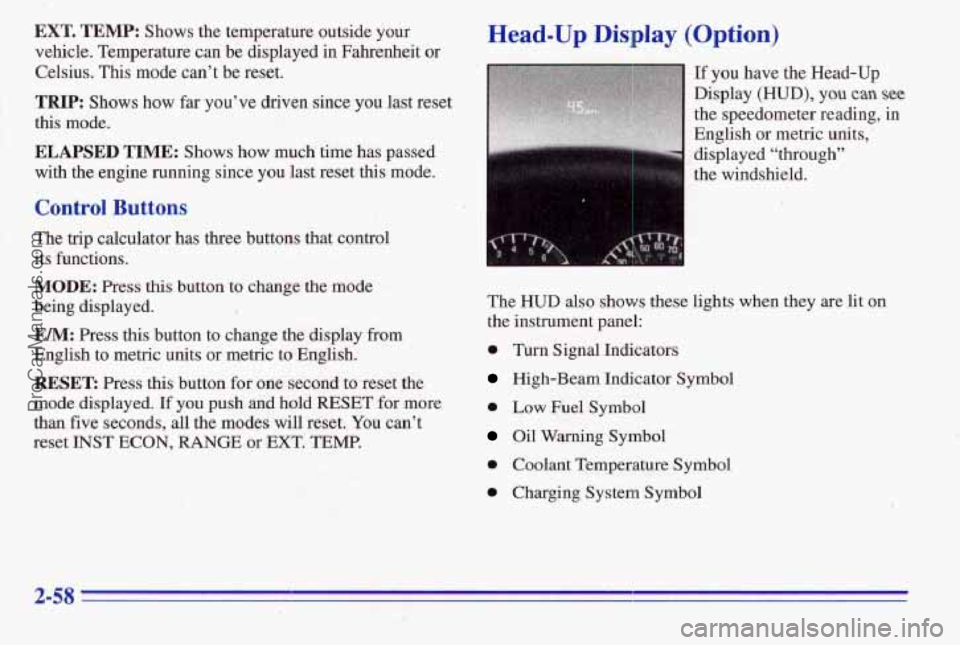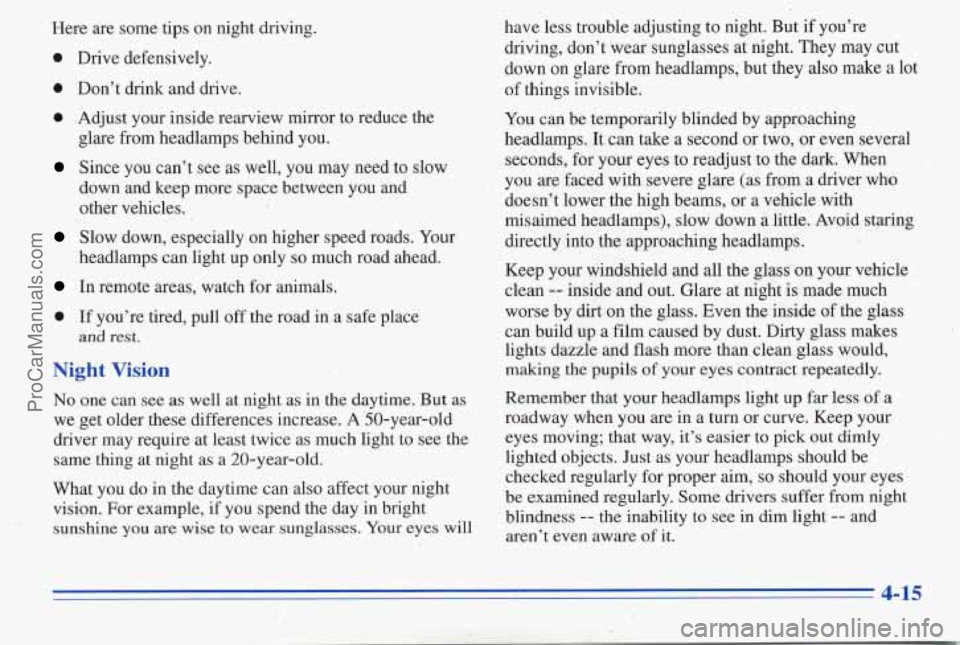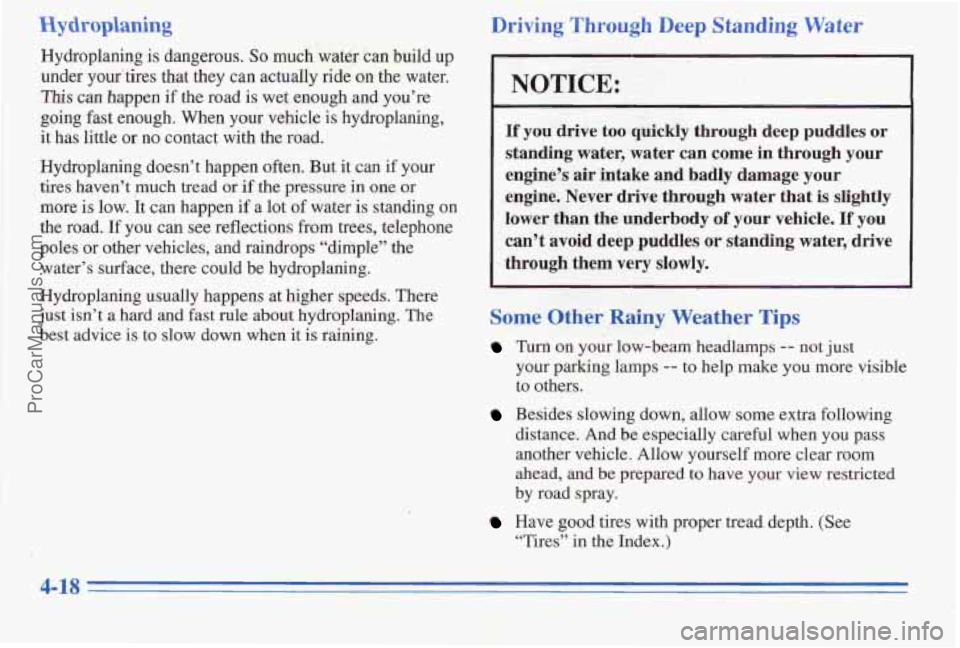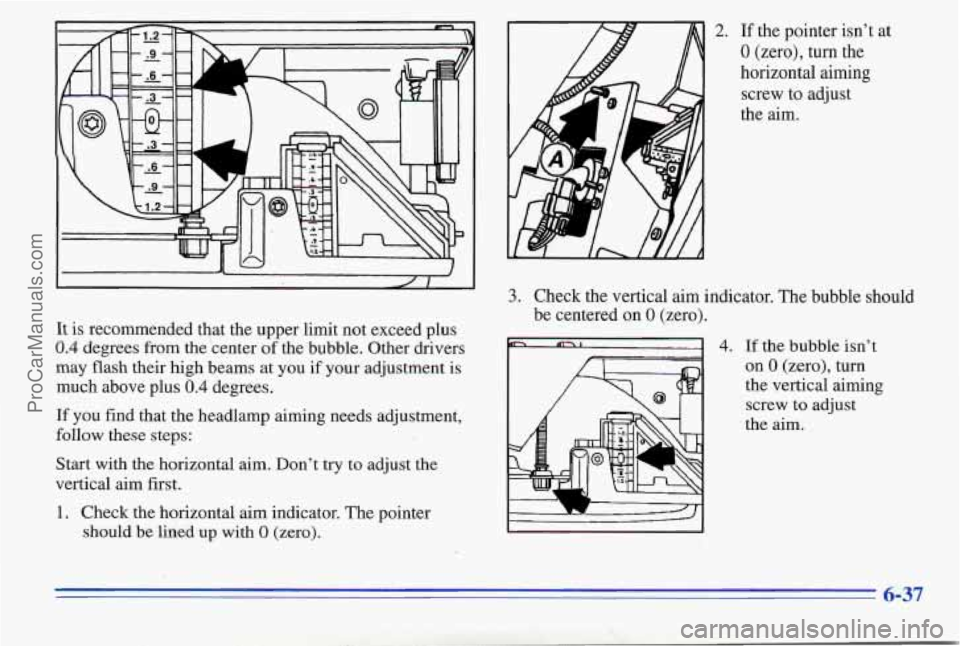1996 PONTIAC PONTIAC high beam
[x] Cancel search: high beamPage 96 of 370

’hrn Signal and Lane Change Indicator
The turn signal has two upward (for right) and two
downward (for left) positions. These positions allow
you
to signal a turn or a lane change.
To signal a turn, move the lever all the way up or down,
When the turn is finished, the lever will return automatically.
An arrow on the instrument
panel will flash in the
direction of the turn or
lane change.
To signal a lane change, just raise or lower the lever
until the arrow starts to flash. Hold
it there until you
complete your lane change. Thelever will return by
itself when you release it.
As you signal a turn or a lane change, if the arrows don’t
flash but just stay
on, a signal bulb may be burned out
and other drivers
won’t see your turn signal.
If a bulb is burned out, replace it to help avoid an
accident.
If the arrows don’t go on at all when you
signal a turn, check for burned-out bulbs and then check
the fuse (see “Fuses and Circuit Breakers” in the Indes).
A chime will sound if you leave your
turn signal on for
more than 1/2 mile (0.8 km).
Headlamp HigldLow Beam Changer
To change your headlamps
from low
beam to high
beam, or high to low, pull
the multifunction lever all
the way toward you. Then
release it. When the high
beams
are on, a. light on the
instrument panel also will
be on.
ProCarManuals.com
Page 102 of 370

Daytime Running Lamps (Option)
Daytime Running Lamps (DRL) can make it easier for
others to see the front
of your vehicle during the day.
DRL can be helpful in many different driving
conditions, but they can be especially helpful in the
short periods after dawn and before sunset.
A light sensor on top of the instrument panel makes the
DRL work, so be sure it isn’t covered.
The DRL system will make your low-beam headlamps
come on at a reduced brightness when:
0 The ignition is on,
0 The headlamp switch is off, and
0 The parking brake is released.
When
the DRL aye on, only your low-beam headlamps
will be on. The taillamps, sidemarker and other lamps
won’t be on.
Your instrument panel won’t be lit up either.
When it’s dark enough outside, your low-beam headlamps
will change to
full brightness. The other lamps that come
on with your headlamps will also
come on. When
it’s bright enough outside, the regular lamps will
go out, and your low-beam headlamps will change to
the reduced brightness of DRL.
To idle your vehicle with the DIU off, set the parking
brake while the ignition is in the
OFF or LOCK
position. Then start your vehicle. The DRL will stay
off until you release the parking brake.
As with any vehicle, you should turn on the regular
headlamp system when you need it.
Fog Lamps
To turn the fog lamps on, press the top of the fog lamp
switch
(C). Press the bottom of the switch to turn the fog
lamps
off. Your parking lamps must be on, or your fog
lamps won’t come on.
The fog lamps will
go off whenever you change to
high-beam headlamps. When you return to low beams,
the fog lamps will come on again.
. 2-33
ProCarManuals.com
Page 127 of 370

EXT. TEMP: Shows the temperature outside your
vehicle. Temperature can be displayed in Fahrenheit or
Celsius. This mode can’t be reset.
TRIP: Shows how far you’ve driv’en since you last reset
this mode.
ELAPSED TIME: Shows how much time has passed
with the engine running since you last reset this mode.
Control Buttons
The trip calculator has three buttons that control
its functions.
MODE: Press this button to change the mode
being displayed.
EM: Press this button to change the display from
English to metric units or metric to English.
RESET: Press this button for one second to reset the
mode displayed.
If you push and hold RESET for more
than five seconds, all the modes will reset. You can’t
reset
INST ECON, RANGE or EXT. TEMP.
Head-Up Display (Option)
If you have the Head-Up
Display
(HUD), you can see
the speedometer reading, in
English or metric units,
’
displayed “through”
the windshield.
The
HUD also shows these lights when they are lit on
the instrument panel:
0 Turn Signal Indicators
High-Beam Indicator Symbol
0 Low Fuel Symbol
Oil Warning Symbol
0 Coolant Temperature Symbol
0 Charging System Symbol
ProCarManuals.com
Page 170 of 370

Here are some tips on night driving.
0 Drive defensively.
0 Don’t drink and dnve.
0 ,Adjust your inside rearview mirror to reduce the
Since you can’t see as well, you may need to slow
glare from headlamps behind you.
down and ke,ep more space between you and
other vehicles.
Slow down, especially on higher speed roads. Your
headlamps can light up only
so much road ahead.
In remote areas, watch for animals.
0 If you’re tired, pull off the road in a safe place
and rest.
Night Vision
No one can see as well at night as in the daytime. But as
we get older these differences increase.
A 50-year-old
driver may require at least twice as much light to see the
same thing at night as a 20-year-old.
What you do in the daytime can also affect your night
vision. For example, if you spend the day in bright
sunshine you are wise to wear sunglasses. Your eyes will
have less trouble adjusting to night. But if you’re
driving, don’t wear sunglasses at night. They may cut
down on glare from headlamps, but they
also make a lot
of things invisible.
You can be temporarily blinded by approaching
headlamps. It can take a second or two,
or even several
seconds, for your eyes to readjust to the dark. When
you
are faced with severe glare (as from a driver who
doesn’t lower the high beams, or a vehicle with
misaimed headlamps), slow down a little. Avoid staring
directly into the approaching headlamps.
Keep your windshield and
all the glass on your vehicle
clean
-- inside and out. Glare at night is made much
worse by dirt
on the glass. Even the inside of the glass
can build
up a film caused by dust. Dirty glass makes
lights dazzle and flash more than clean glass would,
making the pupils of your eyes contract repeatedly.
Remember that your headlamps light
up far less of a
roadway when you are in a turn or curve. Keep your
eyes moving; that way, it’s easier to pick out dimly
lighted objects. Just as your headlamps should be
checked regularly for proper aim,
so should your eyes
be examined regularly. Some drivers suffer from night
blindness
-- the inability to see in dim light -- and
aren’t even aware
of it.
4-15
ProCarManuals.com
Page 173 of 370

Hydroplaning . ., ... 1, , , 2 ,2-,a7:-~+.,: <. .:< ’. -- ’.
Hydroplaning is dangerous. So much water can build up
under your’tires that they can actually ride
on the water.
This can happen if the road is wet enough and you’re
going fast enough. When your vehicle
is hydroplaning,
it has little or no contact with the road.
Hydroplaning doesn’t happen often. But it can
if your
, tires haven’t much tread or if the pressure in one or
more is low.
It can happen if a lot of water is standing on
the road. If you can see reflections from trees, telephone
poles or other vehicles, and raindrops “dimple” the
water’s surface, there could be hydroplaning,
Hydroplaning usually happens at higher speeds. There
just isn’t
a hard and fast rule about hydroplaning. The
best advice is to slow down when
it is raining.
Driving Through Deep Standing Water
NOTICE:
If you drive too quickly through deep puddles or
standing water, water can come in through your
engine’s air intake and badly damage your
.engine. Never drive through water that is slightly
lower than the underbody
of your vehicle. If you
can’t avoid deep puddles or standing water, drive
through them very slowly.
S,ome Other Rainy Weather Tips
Turri on your low-beam headlamps -- not just
your
parking lamps -- to help make you more visible
to others.
Besides slowing down, allow some extra following
distance. And be especially careful when
you pass
another vehicle. Allow yourself more clear room
ahead, and be prepared
to have your view restricted
by road spray.
Have good tires with proper tread depth. (See
“Tires” in
the Index.)
4-18
ProCarManuals.com
Page 264 of 370

It is recommended that the upper limit not exceed plus
0.4 degrees from the center of the bubble. Other drivers
may flash their high beams at you if your adjustment is
much above plus
0.4 degrees.
If you find that the headlamp aiming needs adjustment,
follow these steps:
Start with the horizontal aim. Don’t try to adjust the
vertical aim first.
1. Check the horizontal aim indicator. The pointer
should be
lined up with 0 (zero).
2. If the pointer isn’t at
0 (zero), turn the
horizontal
aiming
screw to adjust
the aim.
3. Check the vertical aim indicator. The bubble should
be centered on
0 (zero).
~1 4.
L-!
If the bubble isn’t
on
0 (zero), turn
the vertical aiming
screw
to adjust
the aim.
6-37
ProCarManuals.com
Page 299 of 370

Replacement Bulbs
Back-up ............................... 3057
Roof-Mountd ....................... 891T2
Exterior Lamps Bulb Number
Center High-Mounted Stoplamp
Shelf-Mounted
........................ 2355 . Fog
2-Door Models ................. H3 (GTP 880)
4-Door Models ......................... 88 1
2-Door Models
...................... 3 157NA
4-Door Models
......................... 889
2-Door Models .................... H4352 (U)
4-Door Models
........................ 9005
Front Parking/Turn Signal
Headlamp. High-Beam
Exterior Lamps Bulb Number
Headlamp. Low-B'eam
2-Door Models
............... ... H4351 (L)
4-Door Models ............... ....... 9006
Headlamp. Auxiliary ...................... 193
License Plate
............................ 194
Light Bar. Front ......................... 3057
Sidemarker. Front
Light Bar Panel. Rear
...................... 194
2-Door Models
.......................... 24
4-Door
Models ........................ 24NA
Sidemarker. Rear ......................... 194
Stop/Tail/Turn Signal
..................... 3057
ProCarManuals.com
Page 300 of 370

Interior Lamps Bulb Number
Ashtray ............................... 194
Center Instrument Cluster
....... 161, 194, 194R
Courtesy Dome
................................. 561
Door .......................... 562 or 212-2
Instrument Panel
........................ 194
GloveBox
.............................. 194
Heater and Air Conditioning Control
... T- 1 .O, T- 1.5
High-Beam Indicator
...................... 161
Instrument Cluster Indicator
.............. PC 16 1
Luggage Compartment .................... 920
Reading
Dome
................................
Inside Rearview Mirror ................... 192
Rear Seat ............................ 906
Turn Signal Indicator . . .............. PC161
Visor Vanity
......... ............... 74
Capacities and Specifications
Automatic Transaxle
Pan Removal and Replacement ... 4 quarts (3.8 L)
After Complete Overhaul ........ 7 quarts (6.7 L)
When drainingheplacing converter or auxiliary
cooler; more fluid
may be needed.
Automatic Transaxle with Overdrive
Pan Removal and Replacement ... 7 quarts (6.7 L)
After Complete Overhaul
....... 10 quarts (9.5 L)
When draining/replacing converter or auxiliary
cooler; more fluid
may be needed.
Cooling System Including Reservoir
3.1L (Code M) ............ 11.6 quarts (10.93 L)
3.4L (Code X) ............. 12.3 qgm i11.65 L)
Refrigerant (R-l34a), Air
Conditioning*
.............. 2.0 pounds (0.9 1 kg)
Engine Crankcase
3.1L (Code M) ................ 4 quarts (3.8 L)
3.4L (Code X) ................. 5 quarts (4.7 L)
Add 1/2 quart more when the filter is changed.
Fuel Tank ................. 16.5 gallons (62.0 L)
*See “Air Conditioning Refrigerants” later in
this section.
6-73
ProCarManuals.com